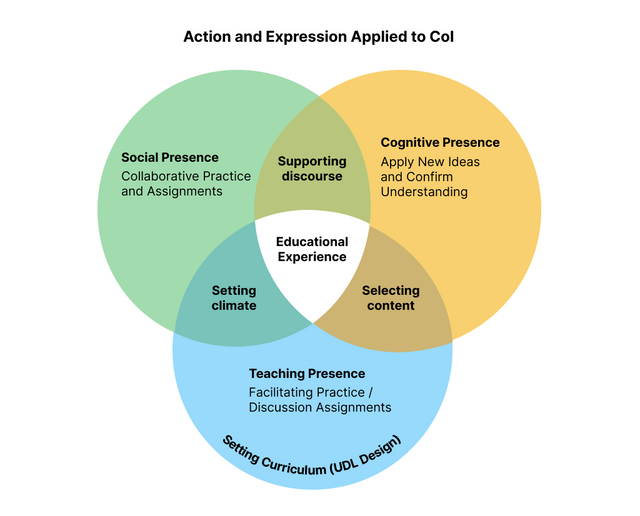Action & Expression and the Community of Inquiry Model
Similar to the three principles of UDL, the three presences of the Community of Inquiry (CoI) framework intersect and overlap. All three presences capture aspects of the Multiple Means of Action and Expression principle, particularly where social presence and cognitive presence overlap, “creating conditions to collaboratively achieve worthwhile educational goals” (Garrison, 2007; Anderson et al., 2001). In particular, where action and expression map to the Col model, learners can express their lived experiences authentically, enriching the learning experience for everyone in the learning community. In the Venn diagram below, you’ll see the Community of Practice model with teaching and learning activities in each presence that relate to action and expression.

If we revisit the CoI model through the lens of Multiple Means of Action and Expression and anti-oppressive educational frameworks, we can use the areas of the Venn diagram to design guiding questions for our reflective practice:
Social Presence
- Are there multiple opportunities for students to express themselves openly and collaboratively?
- Are guidelines or norms established by the community to guide collaboration? Are these regularly revisited and revised?
- Are there different modalities for students to use to express their ideas (verbal, text, video, etc.)?
Cognitive Presence
- Are students supported to check their understanding in different ways (self-check, peer-check, teacher-student conference)?
- Are students invited to apply their learning in meaningful contexts that connect to learning goals (their own and for the course)?
Teaching Presence
- Is intersectional variability a key design lens informing assessment decisions?
- Are students included in the curriculum design process?
- Are all students supported to practice the learning outcomes and given feedback that focuses on growth?
Feedback on Action & Expression for growth
In modules 2 and 3, we reviewed how action-oriented learning and feedback can be supported through the design of our technology-enhanced learning materials. For our learners, frequent, timely and specific feedback also helps to guide their action and expression. (Another example of the interconnections between the UDL principles!)
Action-oriented learning allows students to make mistakes and learn from these to move towards their learning goals.

Mistakes are a place where deep learning happens. We learn more from our mistakes than we do from the things that are easy and right all the time… If we allow the space and grace for the student to retry and take the opportunity to build on their existing knowledge, then we are inviting deeper learning to happen.
In the following webinar excerpt, Laura Facciolo, a Communications professor at George Brown College, talks about the Glow-Grow feedback technique and demonstrates using analytic rubrics in combination with genAI to enhance student feedback processes.
In this webinar excerpt, Laura guides us through Glow-Grow feedback and demonstrates the use of ChatGPT in generating glow and grow feedback statements based on her rubric.
Glowing, Growing, Generating
[music]
This feedback uses the glow grow technique, the glow statements telling you what you did well, the grow statements tell you how you can improve. So that's why I'm structuring my feedback. It's again meeting that quality of consistency. So they have this consistent format. It's also giving compliments, telling them what they did well, supporting motivation and engagement, but being very direct about what needs to happen next, what change needs to be made.
This is how it actually looks in practice. As an example. So let's say I'm assessing an assignment and one of my criterion is that I'm looking at is clarity and organization. So I'm looking for the student's voice to be clear. I'm looking at the writing - is it easy to understand. I'm looking for the content to be organized logically to support guided reading. Possible glow statement I might give is “your writing style is accessible and straightforward and makes it easy for the reader to grasp the content without unnecessary complexion or confusion.”
Possible growth statement is “Consider incorporating visual aids like bullet points or sub headings to break up large texts and provide cues for the reader. This can help improve the readability and accessibility of your e-mail.” So again, I'm referencing the goal being clarity and organization. I'd be very specific about why they might actually make that change, how it's going to help them make the goal, and then providing very specific things they can do to get better to meet that goal.
In order to actually provide this goal reference feedback, we need to make sure that our assessment criteria is there, that is well defined, that's well developed, that it is clear. Our assessment criteria is always based on the learning outcomes for the work that's being assessed. So they're making our grading expectations transparent, clear and explicit to students. So for example, you might communicate your assessment criteria using a rubric. So a lot of us do. It's a scoring tool. It communicates our criteria, would let students know what they're going to be graded on, what we're looking for.
It sets the benchmarks for success, and it supports a consistent evaluation of student work. It helps us remain unbiased towards students and impartial when we're doing our evaluations.
This is a checklist that can help you see if you do use an analytic rubric. For example, is my analytic rubric effective? Is it high quality? So there's different types of, they're called meta rubrics, that help us assess our own rubrics. This is one, for example, it helps you see: is my criteria clear, distinct, and aligned? Do I have these distinct and logically progressive performance levels? Are my descriptors clear? Are my expectations measurable? Is performance addressed as a developmental process? So again, important to remember that if you're using this process, you have to have clear, well defined assessment criteria or else it will not work.
I'd say to deliver feedback, I use the grow-glow technique for each rubric criterion. So in that example, I said clarity and organization. That was my assessment criteria, that's what I mean by that. For each group of criterion developed 5-6 glow grow statements and the tone should be professional and non-technical. And then I insert the rubric. So again, I'll show you what this looks like, but my goal once again is to reduce feedback timelines. You all mentioned it's time consuming to give feedback, to ensure alignment with the criteria because that's a quality or characteristic of high-quality feedback, to support feedback clarity, streamline usability of that feedback and enhance feedback personalization like we heard before. So I'll do a quick demonstration of what this actually looks like.
OK, so I already have an example saved here. So as you can see here, I gave my prompt and I already uploaded my rubric that I had for one communications class. Now as you can see, even when I copy and pasted my rubric, I didn't format it at all. I just copy and paste it as it is. It still understood without me having to do a lot of reformatting. So copy and paste of my rubric, I didn't do much to edit it. I put the spaces because my brain works like that and I don't like to see it very messy, but it completely works about that as well.
Participant: Yes, I use capitals.
Laura: Yeah, that works. Yeah, that would work as well. So as you can see, I submit my rubric, use the prompt, and again, I'm not uploading any student work. This is mine and this is what it gives me. It breaks up my rubric into glow grow statements. My first criterion on my rubric is focus organization and conventions. It's given me 5 glow statements that are directly aligned to that criteria in my rubric. 5 grow statements, and it does that for every single rubric criterion.
Now, can I just copy and paste these directly? Actually you can. I like adding my own voice to them because right now that looks like what we've been spotting and all the work that comes to us.
So you can copy this directly, yes. But right now they, they're a little bit, they sound a little bit AI. But what's actually happening, what are you actually trying to do here? Because again, it's about optimizing, not offloading. You don't want this to be your feedback. I look through all of these. This is the quality assurance piece that you're doing as educator to say, does this reflect my voice? What this is only doing is ensuring that everything is actually aligned.
In order to actually provide this goal referenced feedback, we need to make sure that our assessment criteria is there, that it’s well defined, that it's well developed, that it is clear.
Glowing, Growing, Generating - Runtime 6:14 min
https://youtu.be/UZ-G931uGjk